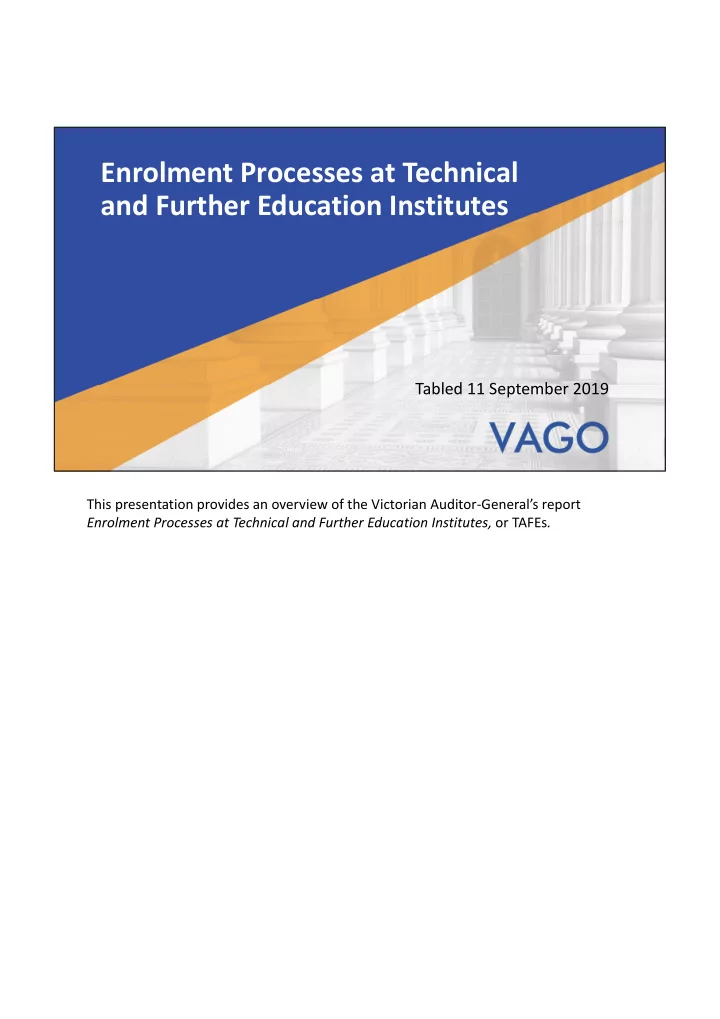

Enrolment Processes at Technical and Further Education Institutes Tabled 11 September 2019 This presentation provides an overview of the Victorian Auditor‐General’s report Enrolment Processes at Technical and Further Education Institutes, or TAFEs .
Victoria’s TAFEs and dual‐sector universities Vocational Education and Training, or VET, helps individuals develop skills and knowledge across various industries. These skills prepare graduates for employment or further education. In Victoria, VET providers include 12 TAFEs and four dual sector universities. For this audit, ‘TAFE’ refers to both standalone TAFEs and dual sector universities. Increasing VET participation is a government priority. It is therefore important that TAFEs have efficient enrolment processes.
Skills First Specific enrolment VET Funding Contract requirements Subsidised VET for eligible individuals The government’s Skills First program subsidises training that targets industry needs while maximising student employment prospects. The Department of Education and Training, or the department, engages VET providers, including TAFEs, to deliver the program using the VET Funding Contract.
Focus of this audit Focus Are TAFE enrolment processes efficient? The audit objective was to determine the efficiency of enrolment processes at TAFEs. This included assessing whether processes are free from unnecessary and burdensome actions; regularly reviewed; completed in a timely manner, and compliant with the department’s VET funding contract.
Who we audited Agencies Box Hill Institute Melbourne Polytechnic Department of Sunraysia Institute of TAFE Education and Training William Angliss Institute of TAFE Swinburne University of Technology The audit examined enrolment processes for government‐subsidised, Skills First training at Box Hill Institute, Melbourne Polytechnic, Sunraysia Institute of TAFE, William Angliss Institute of TAFE, and Swinburne University of Technology. We also examined how the department monitors and supports TAFEs to meet their contractual requirements.
Findings Conclusion Prospective TAFE students do not consistently experience an efficient enrolment process for government‐subsidised training. Overall, we found considerable variation in the efficiency of enrolment processes at the audited TAFEs. This means there is opportunity for TAFEs to improve their systems so that more students experience a quick and easy process.
Efficiency of enrolment processes Online Manual enrolment in‐person process process Sunraysia Swinburne Melbourne Polytechnic Box Hill William Angliss All TAFEs are working to improve, but work is uncoordinated Two of the five audited TAFEs have enrolment processes that are almost entirely online, but also allow individuals to complete steps in person, or through paper forms when needed. The remaining three TAFEs rely on manual processing and in‐person visits to enrol students. Manual processing leads to double handling of information, while in‐person visits may inconvenience those with limited availability. Importantly, all five TAFEs are working to improve their enrolment systems and move more processes online. However, this work is uncoordinated and TAFEs are duplicating effort.
Considering literacy and numeracy skills Resource intensive for TAFEs Unclear requirements Burdensome for literacy TAFE methods and numeracy Unnecessary use of time We also found inefficiencies in how TAFEs assess literacy and numeracy skills as part of enrolment. While the VET funding contract requires TAFEs to consider these skills as part of enrolment, the department has not clearly explained how they should do so. Four of the five audited TAFEs require individuals to complete formal literacy and numeracy tests, regardless of their educational backgrounds such as completing the Victorian Certificate of Education. Conducting these tests can be resource‐intensive for TAFEs and an unnecessary use of an individual’s time.
Monitoring enrolments The typical enrolment process • All TAFEs monitor end‐to‐end conversion Submit enquiry • 3 of 5 TAFEs monitor conversion Submit application between steps Receive offer Accept offer Some TAFEs cannot comprehensively assess Finalise enrolment enrolment efficiency 9 All audited TAFEs measure their end‐to‐end student conversion rates, from initial interest to finalising enrolment. This provides TAFEs with valuable insight into their operational performance. However, some TAFEs cannot comprehensively assess the efficiency of their enrolment processes. Three TAFEs measure conversion rates between key touchpoints within their enrolment processes which gives them better understanding of how well their enrolment processes are working. The other two TAFEs do not perform this analysis, which limits their ability to identify attrition points. The three TAFEs that rely on manual processes also do not know how long prospective students take to complete critical enrolment‐related tasks. By better understanding their enrolment processes, TAFEs can optimise their finite resources to operate more efficiently.
TAFEs’ compliance with the VET funding contract Inconsistent compliance monitoring TAFEs committed, but cannot consistently comply Gaps in TAFEs’ documented processes While TAFEs are committed to meeting the VET funding contract’s enrolment requirements, they are unable to do this consistently. The department provides wide‐ranging guidance to clarify TAFEs’ enrolment obligations, but its compliance monitoring is sometimes inconsistent with the contract’s enrolment‐ related clauses and this prevents a common understanding of how to comply. There are also gaps in TAFEs’ documented processes for two key aspects of enrolment that are required by the contract. These are: • assessing student eligibility for subsidised training, and • conducting a pre‐training review to determine the most suitable training for a prospective student.
Recommendations 1 for Department of Education and Training and TAFEs • Investigate options to standardise or centralise TAFE enrolment systems 3 for Department of Education and Training • Clarify literacy and numeracy requirements • Apply Free TAFE minimum service standards to all subsidised enrolments • Make compliance requirements consistent across various audit tools 2 for TAFEs • Review and update documented enrolment processes • Promptly report all contract non‐compliances to DET We recommended that the department and TAFEs investigate options to standardise or centralise TAFE enrolment systems. We made three further recommendations for the department, on making enrolment requirements clearer and more consistent. We also recommended that TAFEs review and update their documented enrolment processes, and promptly report all contract non‐compliances to the department.
Victorian Auditor‐General’s Office ▌ 5 June 2019 Recovering and reprocessing resources from waste For further information, please view the full report on our website: www.audit.vic.gov.au For further information, please see the full report of this audit on our website, www.audit.vic.gov.au.
Recommend
More recommend